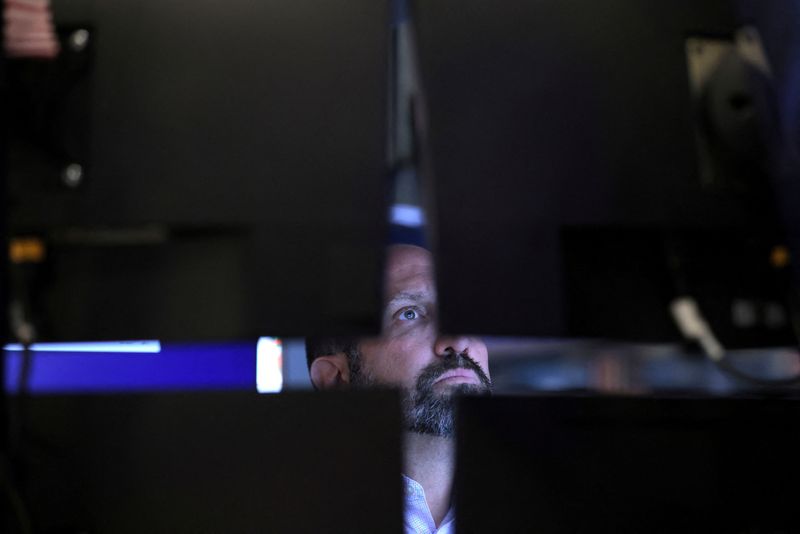 © Reuters Dow Jones, Nasdaq, S&P 500 weekly preview: Stocks rally likely over - analysts
© Reuters Dow Jones, Nasdaq, S&P 500 weekly preview: Stocks rally likely over - analysts
By Senad Karaahmetovic
Despite falling over 1% on Friday, the S&P 500 still managed to gain 1.6% last week. The event-packed week pushed the benchmark U.S. stock market index to the highest level since August.
Tech stocks led the charge higher with the Nasdaq Composite Index (IXIC) trading at the highest levels since the second week of September. The index, which ended the last week 3.3% higher, was up about 20% at one point last week, relative to its late-December low. The Dow Jones Industrial Average (DJI) index closed 0.15% in the red last week.
A week of two halves
The Federal Reserve hiked by 25 basis points to push its benchmark rate to a range of 4.5% to 4.75% - the highest level in 15 years. However, markets interpreted the FOMC statement and Fed Chair Powell's press conference as more dovish than expected. Among other things, Powell said that more rate hikes are required to make sure inflation will continue to cool down.
"We can now say I think for the first time," he said, "that the disinflationary process has started," said Powell, a sentence that likely sent equities higher last week.
As a result, stocks rallied into Thursday with the S&P 500 nearly exceeding 4200. The sentiment was also boosted by a better-than-expected earnings report by Meta Platforms (NASDAQ:META), in addition to a new $40 billion stock buyback plan.
However, the rally ended after-hours on Thursday after three mega-cap companies - Apple (NASDAQ:AAPL), Alphabet (NASDAQ:GOOGL), and Amazon (NASDAQ:AMZN) - all reported somewhat weaker-than-expected results, sending their shares lower.
Moreover, a monster jobs report on Friday dealt another blow to bulls, further accelerating a late-week selloff. While the U.S. economy was supposed to add 185,000 jobs, it added over half a million jobs in January. The unemployment rate fell to 3.4% - the lowest since 1969.
While the data calendar is lighter for this week, the earnings season is set to continue. As of February 03, 242 S&P 500 companies have reported results for the December quarter. According to Goldman Sachs' calculations, 17% of firms have missed EPS expectations by a standard deviation of analyst estimates vs 14% average.
"Results are tracking in line with the 1% year/year decline in S&P 500 EPS expected at the start of earnings season. The typical company that beat EPS expectations has underperformed the S&P 500 by 11 bp the day after reporting, compared with the typical 100 bp of outperformance. This dynamic apparently reflects the fact that supportive recent macro data have outweighed the signal from backward looking 4Q results," Goldman Sachs chief equity strategists wrote in a note.
Among the more important EPS reports for this week, we highlight Walt Disney (NYSE:DIS), Uber (NYSE:UBER), PepsiCo (NASDAQ:PEP), and PayPal (NASDAQ:PYPL).
What are analysts saying about U.S. stocks ahead of a new week?
Goldman Sachs analysts: "Despite the recent rally, there are several reasons we believe upside to US equities remains limited and that the S&P 500 is unlikely to end the year substantially above our year-end target of 4000… The combination of limited upside in our base case and substantial downside risk if the economy dips into recession makes for a challenging distribution of outcomes for US equity investors, especially relative to the alternatives."
JPMorgan analysts: "Positioning is quickly normalizing, and the question is whether there will be a fundamental confirmation for the next leg of the rally. We think that it might end up lacking, we expect an air pocket during Q2 and Q3, with weaker activity and earnings, and consequently believe that Q1 will be an inflection point in the market. We advise to use the current strength in order to reduce exposure."
Morgan Stanley analysts: "While we didn't get the definitive reversal last week for equities we were expecting, the door is still very much open for our call to play out; though it could develop at a bit slower pace."
UBS analysts: "Stocks have enjoyed various rebounds over the past year, mostly driven by hopes that the Federal Reserve will pivot to a more dovish stance. But none of these rallies have lasted. We do expect an inflection point in 2023, as central banks end tightening and the growth outlook improves. At present, we favor a defensive tilt to protect against near-term risks, along with select cyclicals to prepare for a sustained turn in market sentiment."
BTIG analysts: "While trend, breadth, and momentum have all improved meaningfully, we can't help but feel the recent action is a bit of an upside panic on the heels of a massive amount of macro data and company-specific earnings. With the bulk of those events behind us, combined with a significant amount of short covering and call buying, markets look vulnerable to a February hangover."
As of 07:30 EST (12:30 GMT), DJI futures are down 195 points (-0.57%), the S&P 500 futures is down 32 points (-0.78%) while Nasdaq futures trade 123 points lower, almost 1% down on the day.

